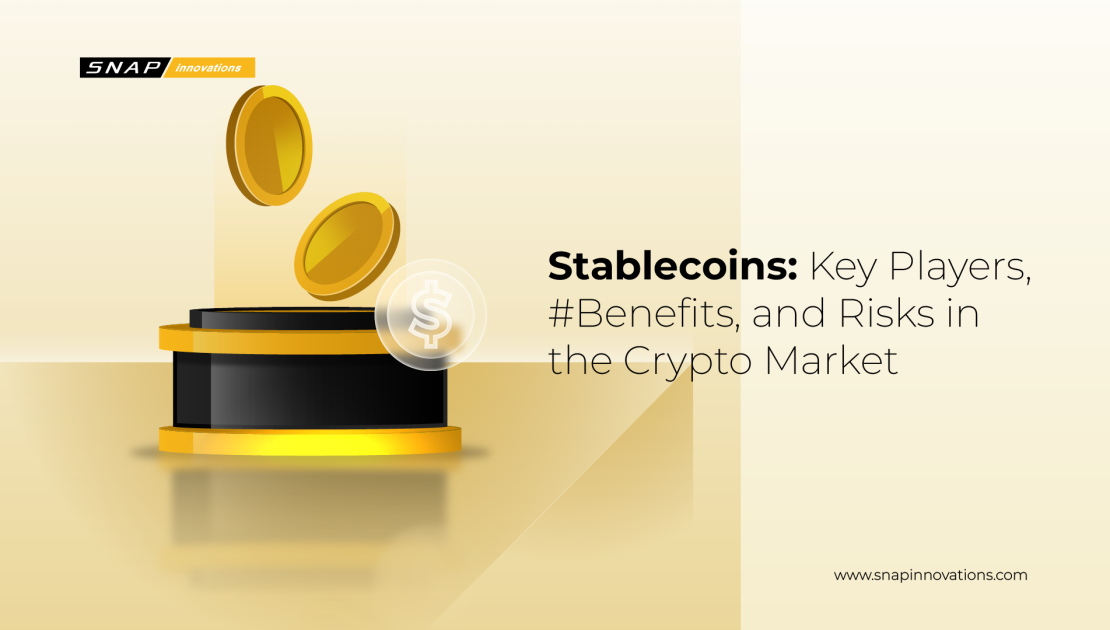7+ Best Stablecoins Dominating the Crypto Market in 2026

In a crypto market defined by volatility, stablecoins have become the silent engines powering trading, payments, and decentralized finance. By 2026, these dollar-pegged digital assets are no longer just tools for parking value during market swings, they are foundational financial instruments used by exchanges, institutions, payment networks, and everyday users worldwide.
From providing instant liquidity and cross-border settlement to enabling complex DeFi strategies, stablecoins now sit at the core of the global crypto economy. This guide explores the 7+ best stablecoins dominating the crypto market in 2026, examining what makes them trusted, how they maintain stability, and why they continue to shape the future of digital finance.
What is a Stablecoin?

A stablecoin is a type of cryptocurrency designed to maintain a stable value by being pegged to a reference asset, most commonly a fiat currency such as the U.S. dollar. Unlike traditional cryptocurrencies that can experience sharp price fluctuations, stablecoins aim to provide price consistency, making them practical for everyday transactions, trading, payments, and financial applications. By combining blockchain technology with stability mechanisms, stablecoins act as a bridge between traditional finance and the digital asset ecosystem.
Stablecoins achieve their stability through different models, each with its own approach to maintaining the peg and managing risk. These models are designed to reduce volatility while preserving the benefits of fast, borderless, and programmable digital money.
Key characteristics of stablecoins include:
- Price Stability: Designed to maintain a steady value, typically pegged 1:1 to a fiat currency like the U.S. dollar
- Liquidity: Widely used as trading pairs and settlement assets across crypto exchanges
- Fast Transactions: Enable quick and low-cost transfers compared to traditional banking systems
- Multiple Backing Models: Can be fiat-backed, crypto-collateralized, or algorithmic
- DeFi Integration: Serve as core assets for lending, borrowing, staking, and yield strategies
- Risk Management Tool: Commonly used to hedge against market volatility without exiting the crypto ecosystem
By offering reliability and flexibility, stablecoins have become essential building blocks of modern digital finance, supporting everything from global payments to advanced decentralized financial products.
Also read: Top 10+ Anti-Money Laundering Software Solutions for Compliance in 2026
7+ Best Stablecoins Dominating the Crypto Market in 2026

This article explores the 7+ best stablecoins dominating the crypto market in 2026, describing what they are, how they maintain stability, their key strengths, and why they matter for investors, traders, and everyday users.
1. Tether (USDT)
Tether (USDT) remains the most widely used stablecoin in the world. Launched as one of the earliest fiat-pegged digital assets, USDT has become the backbone of crypto trading and liquidity provision in global markets.
Stability and Adoption
USDT is pegged to the U.S. dollar and backed by reserves that include a mix of cash, cash equivalents, short-term securities, and other assets. Its primary strength lies in liquidity USDT consistently ranks at or near the top of trading volume across centralized and decentralized exchanges.
Traders use USDT as a base pair for hundreds of digital assets, providing a stable medium between fiat and crypto. Its extensive market presence means it is often the default option for entering or exiting positions.
Strengths
- Massive liquidity and deep market integration
- Wide availability on nearly every exchange and trading pair
- Stable peg with strong market confidence
- Infrastructure support across wallets, trading bots, and DeFi platforms
Considerations
USDT has faced ongoing scrutiny over reserve transparency and composition. In response, the issuer has increased reporting and disclosures to strengthen trust.
USDT continues to dominate because of its liquidity and ubiquity, making it indispensable for active traders and institutional market makers alike.
2. HeLa (HLUSD)
HeLa (HLUSD) has emerged as a new contender among stablecoins, gaining attention for its commitment to transparency and decentralized reserve practices. While newer than some incumbents, HLUSD has rapidly grown in market share.
Stability and Adoption
HLUSD is designed to maintain a tight peg to the U.S. dollar through a combination of reserve assets and algorithmic stability mechanisms that adjust supply in response to market demand. The platform emphasizes clear reserve reporting and regular third-party attestations.
Stakers and liquidity providers in DeFi protocols have adopted HLUSD as a reliable stablecoin for decentralized markets, further enhancing its circulation and utility.
Strengths
- Emphasis on transparent reserves and auditing standards
- DeFi-friendly model with strong integration into emerging ecosystems
- Algorithmic mechanisms to support stability during volatility
- Rapid adoption in decentralized exchanges and yield platforms
Considerations
As a newer entrant, HLUSD’s ultimate long-term resilience is still being tested by market cycles and regulatory developments. However, its innovative model and community engagement position it well for future growth.
HLUSD represents the next generation of stablecoins, blending transparency and innovation to meet both retail and institutional needs.
3. USD Coin (USDC)
USD Coin (USDC) is one of the most respected stablecoins in the market due to its strong regulatory alignment, transparent reserve practices, and backing by established institutions. It has earned widespread trust among institutional and retail users.
Stability and Adoption
USDC is fully backed by U.S. dollar reserves or equivalent cash assets and is subject to regular attestations that verify reserve integrity. Its governance and audit practices are designed to meet stringent compliance standards, making it appealing to regulated entities.
USDC is a common choice for payments, settlement, treasury management, and cross-border transactions due to its reliability and acceptance across exchanges and financial services.
Strengths
- Strong regulatory compliance and institutional trust
- Regular reserve attestations and transparent reporting
- Broad ecosystem usage across exchanges, wallets, and payments
- Frequent use in corporate and enterprise financial solutions
Considerations
USDC’s emphasis on compliance means it may have more conservative reserve practices and verification timelines compared to less regulated alternatives.
In 2026, USDC remains a top stablecoin choice for risk-averse users, institutional players, and financial services integration due to its transparency and governance structure.
4. PayPal USD (PYUSD)
PayPal USD (PYUSD) is a USD-pegged stablecoin launched by PayPal to integrate digital assets directly into its global payments ecosystem. Its mainstream backing has accelerated adoption among everyday users and merchants.
Stability and Adoption
PYUSD maintains its peg through trusted reserves and is integrated directly into PayPal’s checkout and wallet systems. For users, this means immediate utility, stablecoin holdings can be spent, sent, or received like any other balance within PayPal’s ecosystem.
The combination of traditional payments infrastructure and blockchain technology makes PYUSD a unique bridge between fiat and crypto.
Strengths
- Seamless integration with PayPal’s global user base
- Easy usability for payments and peer-to-peer transfers
- Broad acceptance through merchant networks
- Transparent reserve practices aligned with corporate governance
Considerations
While PYUSD’s adoption is strong in payment use cases, its trading volume on decentralized exchanges is less compared to market-leading stablecoins like USDT or USDC.
PYUSD is an important stablecoin in 2026 because it brings cryptocurrency closer to everyday financial use through mainstream payment systems.
5. TrueUSD (TUSD)
TrueUSD (TUSD) is a fiat-collateralized stablecoin designed to maintain a strong peg through legally enforceable trust structures and transparent reserve mechanisms.
Stability and Adoption
TUSD is backed 1:1 by U.S. dollar reserves held in custodial accounts, with regular attestations verifying transparency. The legal framework supporting TUSD’s reserves gives users added peace of mind, particularly for corporate treasury and institutional exposures.
It is widely available on exchanges and is used for trading, hedging, and liquidity provisioning.
Strengths
- Full fiat backing with clear legal custodial structures
- Regular attestations and accountability
- Reliable peg performance
- Strong adoption in decentralized and centralized venues
Considerations
TUSD may offer slightly lower yield opportunities compared to algorithmic or emerging stablecoins used in DeFi interactions.
TUSD remains a stable choice in 2026 for users who prioritize legal integrity and fully reserved backing.
6. Dai (DAI)
Dai (DAI) is a crypto-collateralized stablecoin native to decentralized finance protocols. Unlike fiat-backed stablecoins, DAI maintains its peg through over-collateralized positions in other digital assets.
Stability and Adoption
DAI is an algorithmic stablecoin and is not backed by fiat reserves. Instead, users lock various crypto assets as collateral in smart contracts to generate DAI. If the value of the collateral falls below required thresholds, automated liquidation mechanisms protect the system.
This decentralized approach makes DAI popular among DeFi users and projects that prioritize censorship resistance and autonomy.
Strengths
- Decentralized governance and collateral model
- Strong DeFi integration and composability
- Resistant to centralized control or regulatory interference
- Mature ecosystem of protocols using DAI as liquidity
Considerations
DAI’s peg stability depends on collateral performance, meaning extreme market volatility can pose challenges.
DAI remains essential in 2026 for decentralized ecosystems that require trustless, permissionless stable value.
7. Ripple USD (RLUSD)
Ripple USD (RLUSD) is a stablecoin designed specifically for enterprise use, cross-border payments, and financial infrastructure modernization. It is part of Ripple’s broader suite of enterprise blockchain solutions.
Stability and Adoption
RLUSD maintains its peg through transparent reserves and is designed for fast settlement and low-cost global transfers. Ripple’s focus on institutional adoption means RLUSD is often used by financial institutions, payment providers, and cross-border remittance platforms.
Strengths
- Enterprise-oriented design for payments and liquidity
- Fast settlement and low transaction costs
- Strong integration with Ripple’s global financial ecosystem
- Clear reserve practices and audit frameworks
Considerations
RLUSD’s usage is more specialized toward institutional applications than general retail trading.
In 2026, RLUSD plays a critical role in stablecoin adoption by traditional financial institutions and payment networks.
8. Pax Dollar (USDP)
Pax Dollar (USDP) is a fully fiat-backed stablecoin that emphasizes regulatory compliance and transparency. It is structured to meet institutional risk standards and support compliance frameworks.
Stability and Adoption
USDP maintains a 1:1 backing with U.S. dollar reserves, with ongoing attestations verifying the reserve status. It is widely used in trading, hedging, and capital preservation strategies.
Strengths
- Transparent and regulated reserve backing
- Institutional compatibility with compliance frameworks
- Steady peg performance
- Support across exchanges and custody solutions
Considerations
Like other fully backed stablecoins, USDP’s growth is tied to trust in reserve practices and regulatory alignment.
USDP remains a solid choice in 2026 for users seeking regulation-aligned, fully backed stable value.
9. Gemini Dollar (GUSD)
Gemini Dollar (GUSD) was created with regulatory compliance and security at the forefront. It is issued by a trusted exchange and adheres to stringent standards for reserve backing.
Stability and Adoption
GUSD maintains a 1:1 dollar peg with fully reserved backing in secure custody accounts. Its governance and reporting practices are designed to meet regulatory expectations, earning trust among institutional and retail users.
Strengths
- Strong regulatory oversight and compliance
- Transparent reserve and auditing
- Backed by a reputable institution
- Used in trading, payments, and custody solutions
Considerations
While widely used, GUSD’s adoption is somewhat narrower than the largest stablecoins due to competition and platform focus.
In 2026, GUSD remains a dependable stablecoin for risk-aware users and regulated environments.
Read Next: Top 17 Layer 1 Blockchains with Strong Ecosystems in 2026
Why Stablecoins Matter in 2026

In 2026, stablecoins are no longer niche financial tools, they are critical infrastructure within the global crypto and digital finance ecosystem. As blockchain adoption expands across payments, trading, and decentralized finance, stablecoins provide the stability and efficiency needed to connect volatile digital assets with real-world financial use cases. Their ability to combine price stability with the speed and transparency of blockchain technology makes them indispensable for both individuals and institutions.
Key reasons why stablecoins matter in 2026 include:
- Market Stability and Risk Management: Stablecoins allow traders and investors to preserve value during periods of high market volatility without moving funds back to traditional banking systems.
- Liquidity Backbone of Crypto Markets: Most digital asset trading pairs are priced against stablecoins, making them essential for price discovery and efficient market operations.
- Efficient Cross-Border Payments: Stablecoins enable fast, low-cost international transfers, reducing reliance on slow and expensive traditional remittance networks.
- Growth of Decentralized Finance (DeFi): Lending, borrowing, staking, and yield protocols rely heavily on stablecoins as base assets for smart contracts.
- Institutional and Enterprise Adoption: Banks, fintech firms, and payment providers increasingly use stablecoins for settlement, treasury management, and on-chain liquidity.
- Bridge Between Fiat and Crypto: Stablecoins provide a seamless gateway for users entering or exiting the crypto ecosystem without exposure to extreme price swings.
As regulation becomes clearer and technology more robust, stablecoins continue to evolve into trusted digital representations of fiat money, playing a central role in shaping the future of global finance.
Stablecoins and Regulation
As stablecoins have grown, regulators worldwide have focused on ensuring transparency, reserve integrity, and consumer protection. In 2026, regulatory frameworks in multiple jurisdictions require enhanced reporting, reserve verification, and compliance with anti-money-laundering standards.
This is especially impactful for fiat-backed stablecoins like USDC, TUSD, USDP, and GUSD, where reserve backing must be auditable and transparent to meet compliance expectations.
Decentralized stablecoins like DAI continue to operate under market-driven models, but their adoption is scrutinized for systemic risk exposure and smart contract safety.
Conclusion
As the cryptocurrency ecosystem continues to mature in 2026, stablecoins have firmly established themselves as essential pillars of the digital financial system. The leading stablecoins dominating the market today combine strong price stability, deep liquidity, transparent reserve mechanisms, and broad real-world adoption across trading, payments, and decentralized finance.
Whether fully fiat-backed, crypto-collateralized, or designed for enterprise use, each stablecoin discussed in this guide serves a distinct purpose and risk profile. By understanding how these stablecoins operate and where they are best used, investors, traders, and institutions can manage volatility more effectively, move value with greater efficiency, and participate confidently in the evolving crypto economy.
Disclaimer: The information provided by Snap Innovations in this article is intended for general informational purposes and does not reflect the company’s opinion. It is not intended as investment advice or recommendations. Readers are strongly advised to conduct their own thorough research and consult with a qualified financial advisor before making any financial decisions.
Muhammad Ermanja
I am a specialist in the financial technology industry, focusing on trading technology solutions and brokerage infrastructure. With over six years of experience, I consistently explore the development, implementation, and integration of multi-asset trading systems, low-latency platforms, and brokerage automation tools. My insights revolve around how technology can enhance execution speed, risk management, and overall operational efficiency for brokers and professional traders. Every analysis and article I create is grounded in research and real-world industry challenges, aiming to help financial institutions and trading firms build scalable, secure, and high-performing systems in the rapidly evolving landscape of modern finance.

